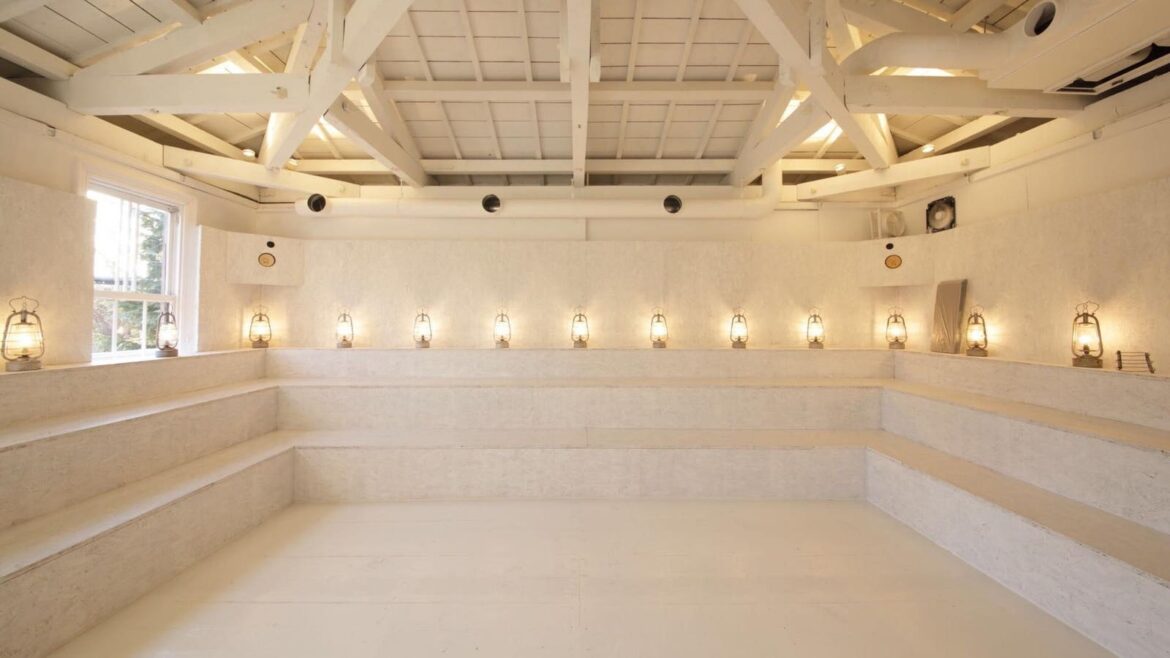The first time I ever sat on a flight heard ‘we’ve begun our descent’, Kyoto had been where I wanted to go. Decades later, at the end of this August, I finally made it—just in time for Typhoon Shanshan. Only 48 hours to spare and a looming city-wide shutdown didn’t exactly scream ‘perfect getaway.’ Yet, that’s Kyoto for you—even in the least ideal circumstances, it still sweeps you off your feet.
You don’t have to look hard to find beautiful design in Japan’s former capital. It’s all around: in the bold typography that lines the sidewalks, the small linen curtains that mark a restaurant’s entrance, the origami lanterns that dangle along the riverside, and the tidy nature of the streets. They make everything look in vogue, even the saloon-style Lawson Station (a convenience store chain) logo, which, if found in Texas, would look like a parody of itself. Every detail, from the dainty flower arrangements in shop windows to the symmetry of sake bottles on bar counters, feels effortless and intentional all at once.
It’s easy to fall in love with the place. It’s like a summer romance you just can’t shake, one you know will still occupy your thoughts years later. With a crush like Kyoto, it’s easy to get lost and let your mind wander. But don’t get too swept away—stay present because every detail counts. Here’s how an art and design lover can make the most of 48 hours with their new muse, Kyoto.
_________________________________________________________
Friday
3 p.m. | Check into Ace Hotel Kyoto
I arrive at Ace Hotel Kyoto, designed by legendary architect Kengo Kuma in the former Kyoto Central Telephone Office. There are couples in monochrome linen overalls and canvas totes saying things like ‘Sleeping in Seattle.’ The receptionist who checks me in wears a black hat that reads ‘FBI Warning,’ and by day, the long wooden table in the lobby is packed with people working on their laptops—an ideal setting for a Kyoto meet-cute. My room has nuanced touches like a vinyl player with niche records by artists like Chief Ebenezer Obey. On the second floor, the PIOPIKO taco bar was abuzz when I stopped by for an afternoon aperitif. And just outside, the streets are lined with ceramics and vintage shops, right in the heart of it all.
Ace Hotel Kyoto
Ace Hotel Kyoto
MORE FROM FORBES ADVISOR


4 p.m. | Local Design Shops
Kyoto is the kind of place you could roam around endlessly. The streets are compact, and it feels like you could spread your arms and reach from one side to the other. I wander around and stumble upon Osugi Shoten, a small antique ceramic store. The shopkeeper enthusiastically takes me through the different periods of Japanese pottery. When I finally chose a cup, he noticed a tiny scratch I hadn’t seen and knocked 9,600 yen off the price without me asking—only in Japan. Among my other favorite stops were mumokuteki goods & wears, Ordinary Fits, Kapital, and Kyo Amahare. The more denim and vintage stores you go to, the better.
Kyo Amahare
Satoshi Asakawa
6 p.m. | Pontocho Alley
With time to spare before dinner, I head to Pontocho Alley, a narrow lane by the river filled with restaurants and bars. The wooden façades and lantern-lit paths are the perfect introduction to a city. A glass of sake in one, an order of yakitori in another, and a crisp pour of Japanese whiskey in the next. Roam around and drop in anywhere that calls you. I ended up at Kyotoen Yakitori, which, if you ask me, is well-deserving of its 4.9-star Google Review rating.
7 p.m. | Sushi Rakumi
Dinner is a 20-or-so-course, 2-Michelin-star affair at Sushi Rakumi, a tiny wooden sushi counter on a quiet street in the Higashiyama-ku neighborhood. With just eight seats, the intimate setting turns strangers into fast friends. Corn custard with uni, Pacific saury, otoro nigiri, and the sweetest melon I’ve ever had are just some highlights of this whirlwind culinary experience.
_________________________________________________________
Saturday
8 a.m. | Stumptown at Ace Hotel Kyoto
Stumptown’s first international outpost, tucked right inside the hotel, brings a slice of the Pacific Northwest to Kyoto. It’s a dream for coffee aficionados—espresso, drip coffee, and whole beans are all on hand, along with Stumptown’s signature merchandise. But for non-coffee drinkers like me, it’s the in-house pastries that steal the show. Whether you’re grabbing a morning pick-me-up or just in it for the sweets, it’s a great way to start the day.
Stumptown at Ace Hotel Kyoto
Stumptown at Ace Hotel Kyoto
9 a.m. | Arashiyama Bamboo Forest
A short trip to the Arashiyama Bamboo Forest brings a change of pace. Walking through the towering bamboo stalks between the soft sounds of branches swaying and the occasional click of a camera feels almost meditative. Along the way, you’ll pass small shrines and can even detour to Okochi-Sanso Villa, a beautiful garden park with sweeping views of the Kyoto mountains.
11 a.m. | Katsura Imperial Villa
A visit to Katsura Imperial Villa reveals one of Japan’s finest examples of traditional architecture and landscaping. Designed by the renowned architect Kobori Enshū, there are areas for moon bathing and tea ceremonies—a testament to a culture deeply rooted in nature. Its simplicity and harmonious qualities have made it an inspiration for names like Le Corbusier and Walter Gropius, and the Villa itself gives a glimpse into the world of Japan’s aristocracy during the Edo period.
Katsura Imperial Villa
Natalie Stoclet
1 p.m. | Garden of Fine Arts
For a dose of modernity, visit the Garden of Fine Arts, an open-air museum designed by Tadao Ando. The minimalist concrete walkways and glass features act as a stark backdrop for reproductions of classic works like Leonardo da Vinci’s The Last Supper and Claude Monet’s Water Lilies on ceramic tiles. It’s a striking reminder that even in Kyoto’s exceptional and historic design culture, there’s space for innovation.
4 p.m. | Nishiki Market
Nishiki Market is alive with energy but not overwhelming at this hour. It’s the perfect set-up to explore the culinary delights of Kyoto, from steamy gyozas to sweet mochi, all in one place. One of the more charming aspects of Kyoto’s culture becomes clear: the importance of manners and presence. There’s no walking around while eating here. Like many of the markets in Japan, you’re required to sit down and take the time to enjoy your food.
Owen Roth
Owen Roth
9 p.m. | Gion
The confidantes I asked for Kyoto recommendations told me to spend the evening in the Gion neighborhood. I found that the lantern-lit streets and softly glowing restaurants set a cinematic scene. I took my time and walked along the Kamo River, where the sound of the water and the occasional sight of Geishas added to the atmosphere. Stop by The Common One Bar, a hidden spot with no menu that pours cocktails with an almost scientific seriousness.
_________________________________________________________
Sunday
8.30 a.m. | Walden Woods Kyoto
The coffee and matcha scene in Kyoto is an art form in itself. Get a taste of it at Walden Woods, a minimalist café that blends modern design with natural materials. The calming concrete space calls for a reflective moment before the day’s adventures.
Kawai Kanjiro’s House
Natalie Stoclet
10 a.m. | Kawai Kanjiro’s House
Kawai Kanjiro was a master ceramicist and key figure in the Mingei (folk craft) movement, and his house, now a museum in Higashiyama, remains just as he left it. Not only did Kanjiro design the house that he lived in in the 1930s, but the pottwer also crafted most of the furniture and artwork. I slip into the provided slippers and wander through rooms filled with pottery, woodwork, and sculptures that reflect his deep commitment to craftsmanship. It’s a peaceful, meditative space where design and life are inseparable.
11 a.m. | Fushimi Inari Shrine
I continued to Fushimi Inari Shrine, a must for the design-enthusiast. The iconic red torii gates seem to stretch on forever. It’s easy to lose track of time as you move through the bright vermillion structures, which feel simultaneously grand and intimate. Each gate is donated by individuals and businesses, a tradition that has lasted for centuries to honor Inari, the Shinto god of rice and prosperity, among other things.
Fushimi Inari Shrine
Mauricio Ortiz
12.30 p.m. | Southern Higashiyama and Kiyomizu-dera
Although I wished it was longer, the next hour was spent strolling through Southern Higashiyama, the historic Geisha district. The wooden Machiya houses and narrow lanes offer a glimpse of old Kyoto. The aroma of freshly made yatsuhashi, Kyoto’s signature sweet, pulls me toward a nearby shop. Vibrant paper lanterns line the streets, and the sounds of shamisen music echo from a nearby tea house. From here, I visited Kiyomizu-dera, one of Kyoto’s most famous temples, perched on a hillside with panoramic views of the city.
2 p.m. | Tempura Endo Yasaka
My last lunch was at Tempura Endo Yasaka in nearby Gion. Facing the Kenninji Temple, with the famous Yasaka Pagoda in front, this elegant restaurant serves light, crispy tempura. Set in a former Meiji Era teahouse where Geisha and Maiko performers would entertain guests, savor a menu of lightly battered seafood and vegetables. The attention to detail of Kyoto’s broader design ethos—thoughtful and understated.


AloJapan.com